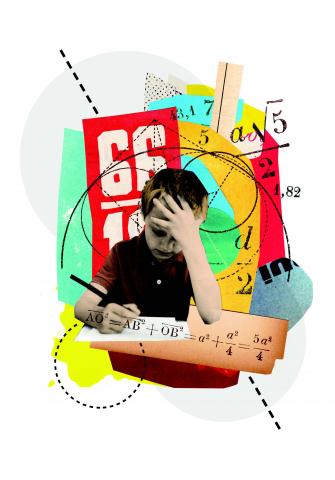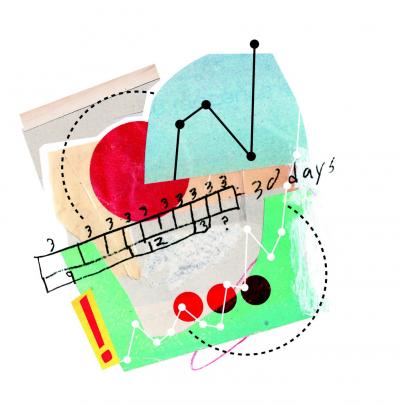Helping Students with Learning Disabilities to Learn Math

A teaching strategy being developed and researched by an assistant professor of Special Education is showing promise in helping students with learning disabilities to understand fractions.
It may even hold long-term promise in helping people without learning disabilities overcome their math anxiety and fear of fractions.
The Model Drawing Strategy helps students to discern the meaning of mathematical word problems by having them draw a diagram to help them visualize and interpret the relationships between the numbers presented to them.
Two studies led by Minyi Shih Dennis—one of high school students with learning disabilities and another of fourth-graders with learning disabilities—have allowed small groups of students to dramatically improve their scores in tests demonstrating fraction skills.
And developing fraction skills, said Dennis, is critical in developing something math teachers call “proportional reasoning,” a skill critical to learning higher math concepts, including basic algebra.
Students who have learning disabilities with math are very often intelligent, but have difficulty with the “cognitive processing” of quantities or the numeric symbols that represent those quantities, Dennis said.
“For example, when we say the number 5. Automatically, we can associate 5 as a number that is bigger than 3, that is smaller than 10,” Dennis said. “That kind of intuition might not come as natural for those kids. They may need some explicit
instructions in terms of repeated exposure on the actual five objects. Compare those to 10 objects.
“Fractions are even more complex in that it’s not just about a discreet quantity. It’s about the relationship between a part and a whole. Therefore, when we say three-fifths, if we just use the symbol, the kids may not understand what we mean
in one symbol 3 and 5. But then if we show them in a diagram the relationship between the part and whole, that can enhance their understanding of the symbol 3/5.”
In the Model Drawing Strategy, students are taught to solve a word problem employing six steps:
- Read the problem aloud to gain an initial understanding of it, the givens and the goal.
- Decide what is important by identifying and listing information essential to solving it.
- Create a schematic diagram representing the problem. The student draws a rectangular bar, using a stencil, and represents relationships between the fraction’s parts and the whole by partitioning the bar.
- Reread each sentence and mark the known information onto the diagram.
- Refer back to the diagram and decide the relative magnitude of each fraction.
- Answer the question and check to make sure that it is reasonable.
Signs of Promise
In the first study in 2015, three California high school students with learning disabilities all showed dramatic improvement in their ability to solve word problems involving fractions and percentages after receiving instructional intervention.
One of the students who scored 0 in baseline tests improved to 48 percent in fraction word problems and 90 percent in percentage word problems. Another student improved from 3 percent to 94 percent in solving percentage word problems.
In 2016, Dennis and doctoral student Emily Sharp decided to try the Model Drawing Strategy with elementary students, specifically three fourth-graders who had fared poorly on the Pennsylvania System of School Assessment tests, a standardized exam that is administered statewide.
After weeks of receiving instructional intervention, all three students showed tremendous improvement in their ability to solve word problems involving fractions. The three reached 100 percent proficiency during the intervention and retained the ability during a maintenance phase of the study. However, two showed some regression in post-intervention generalized testing.
An abstract describing the study said those two students “reverted to whole number bias when fractions were presented as symbols only” and may need “targeted practice to generalize the relationship between the numerator [the top number of the fraction] and the denominator [the bottom number]."
Nonetheless, Dennis said she was pleasantly surprised at how well the fourth-graders did with Model Drawing Strategy. “In a way, I knew that these strategies might help, but I was not anticipating such a great effect,” she said. As a result, she now plans to focus more of her research on targeting younger age students.
“People have become more aware that there is a need for students with learning disabilities to have a better understanding of fraction concepts,” Dennis said. “Fractions are a way for students to build the concepts of number patterns, using the underlying concept we call rational reasoning. When students don’t have that kind of proportional reasoning, it’s going to be more difficult for students to be successful in algebra.”
 Why do some children have more extreme trouble learning math than others?
Why do some children have more extreme trouble learning math than others?
Dennis believes that there is a cognitive processing issue in the brain not unlike what some people with reading disabilities such as dyslexia experience. But so far the research into math learning disabilities and how they relate to specific parts of the brain has not been as extensive, she said.
“There are some neuro-cognitive psychologists that [say] math concept learning process is much more complex compared to reading because you are not only dealing with the symbols, you are dealing with the concept of quantity,” Dennis said. “It may involve more parts of the brain than those that deal with reading. It’s very difficult to localize the area responsible for math concept processing.”
Until recently, math education for children with learning disabilities concentrated on building fluency in basic concepts, such as whole number addition and subtraction.
“Granted, those are very important concepts, but we cannot stop there,” Dennis said. “There are going to be more advanced math skills that the kids need to learn. I have very high expectations for students with learning disabilities because, despite the cognitive processing issue, they have average to high range of IQ. They have the potential to learn. It’s the matter of how to help them learn.”
A Common Issue
Fear of fractions is a common issue among the general public, not just the learning disabled, Dennis said.
“I teach a class that is called ‘Academic Intervention for Secondary Level Students.’ In that class, I focus on math intervention. A very specific topic I cover in that class is fraction intervention. And you will not believe how many of my graduate students told me they do not understand fractions,” Dennis said.
“What saddened me most was that some students did not have a good experience with fractions because their math teacher somehow did not explain the concept well, but then they blamed the students for not getting it.
“So in a way, the math teachers were blaming the victims. They humiliated them. They yelled at them for not being able to learn fractions. From those experiences, my students say they will have nothing to do with fractions. I’ve heard that from my students over and over, and there needs to be something done differently about teaching fractions.”
Dennis’ research may be pointing in the right direction.
“We are not just asking kids to read. We also have a safeguard,” Dennis said. “We also ask kids to paraphrase, use their own words to describe the problem. Those are the things to help us make sure that the kids who read the problems understand what they are reading.
“There have been studies that show when you present a word problem to kids, regardless of their disability types, a high percentage of the kids just put two numbers together, depending on the content of the instruction they are receiving at that moment. So if their teacher is currently teaching them addition, they just put two numbers together and add. If they are, at the time, receiving instruction in multiplication, they just put two numbers together and multiply.
“This is a problem with kids across the board, not just kids with learning disabilities,” Dennis said. “The findings of our studies show that it is a promising approach to have the students reflect what they thought what the problem is supposed to be.”
Though the results of the studies were promising, it will take more study for the Model Drawing Strategy to gain wider acceptance among educators. One of the limits of these studies was their small sample sizes, Dennis concedes.
To that end, Dennis hopes to conduct a larger study that compares the progress of students who get Model Drawing Strategy intervention to those who do not.
First, however, she is looking to refine the model drawing lesson plan by adding one more mathematical concept to the intervention. While the current lesson plan emphasizes the concept as a fraction being a part of the whole, it does not address “the measurement concept of fractions,” Dennis said. “That is another important concept for students to learn, to show that a fraction is a number that can be represented on a number line.”
Dennis’ obvious passion in developing ways of reaching students with learning disabilities has its roots in her time as an elementary school teacher in her native Taipei, Taiwan. There, she remembers one boy in particular who struggled, though she could never understand the reasons.
“Back then I did not have any concept of learning disabilities,” Dennis said. “I just noticed that he was different. I looked at his record and he had an IQ of 105, which is within normal range. But then he had difficulty academically in my class. He also had very poor handwriting, poor reading comprehension.
“I taught him for two years, tried to fill in the gaps. I tried to teach him the things he was supposed to know, but didn’t know.”
His struggles remained puzzling to her until her pursuit of a master’s in educational psychology at the University of Texas at Austin led her to a class called “Introduction to Learning Disabilities and Behavior Disorders.”
“As I read about learning disabilities, that student came back to mind,” she recalled. “I think he had a processing issue, a cognitive processing issue. He had very poor hand-eye coordination, difficulty in reading comprehension.
“My current focus is on math intervention, but my heart is on the cognitive processing issue. Eventually I want to get to the bottom of it....”
In the meantime, Dennis said, she'll continue to focus on ways to help students better understand mathematical concepts such as fractions. “Students with learning disabilities, they do not lack intelligence, they are not lazy, like many people assume," she said. "It’s just that they process things differently, therefore they need some additional or unique instruction to help them get around.”